Want to know a secret?
Writing enormously popular content is not something special reserved for the internet-famous or millionaire marketers who have a team of editors.
Anyone can do it.
For example, I wrote the second most shared article on the Buffer blog in 2015: 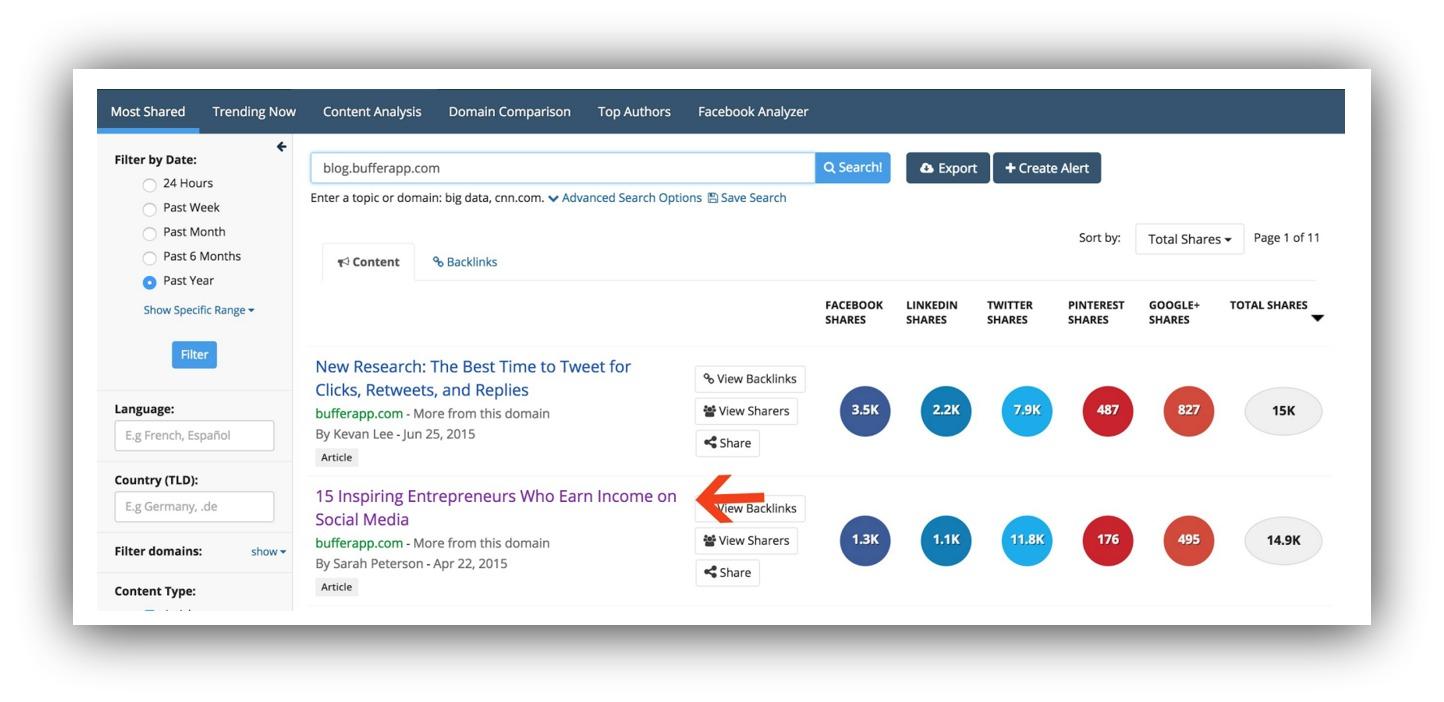
And one of the 50 most popular posts on Fast Company in 2015.
My Power Words guide on Sumo quickly rose to the top of the charts just a month after it was published: 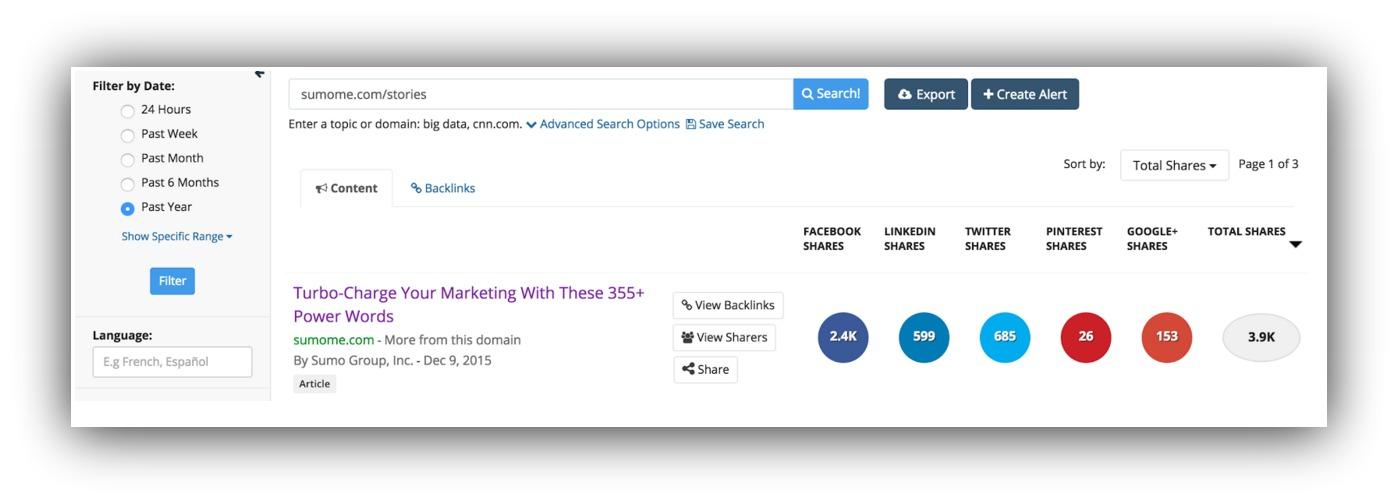
And my article about blog advertising on Boost Blog Traffic is in the top 10 over the past year:

One of my articles on Elite Daily landed 23,000 social shares…
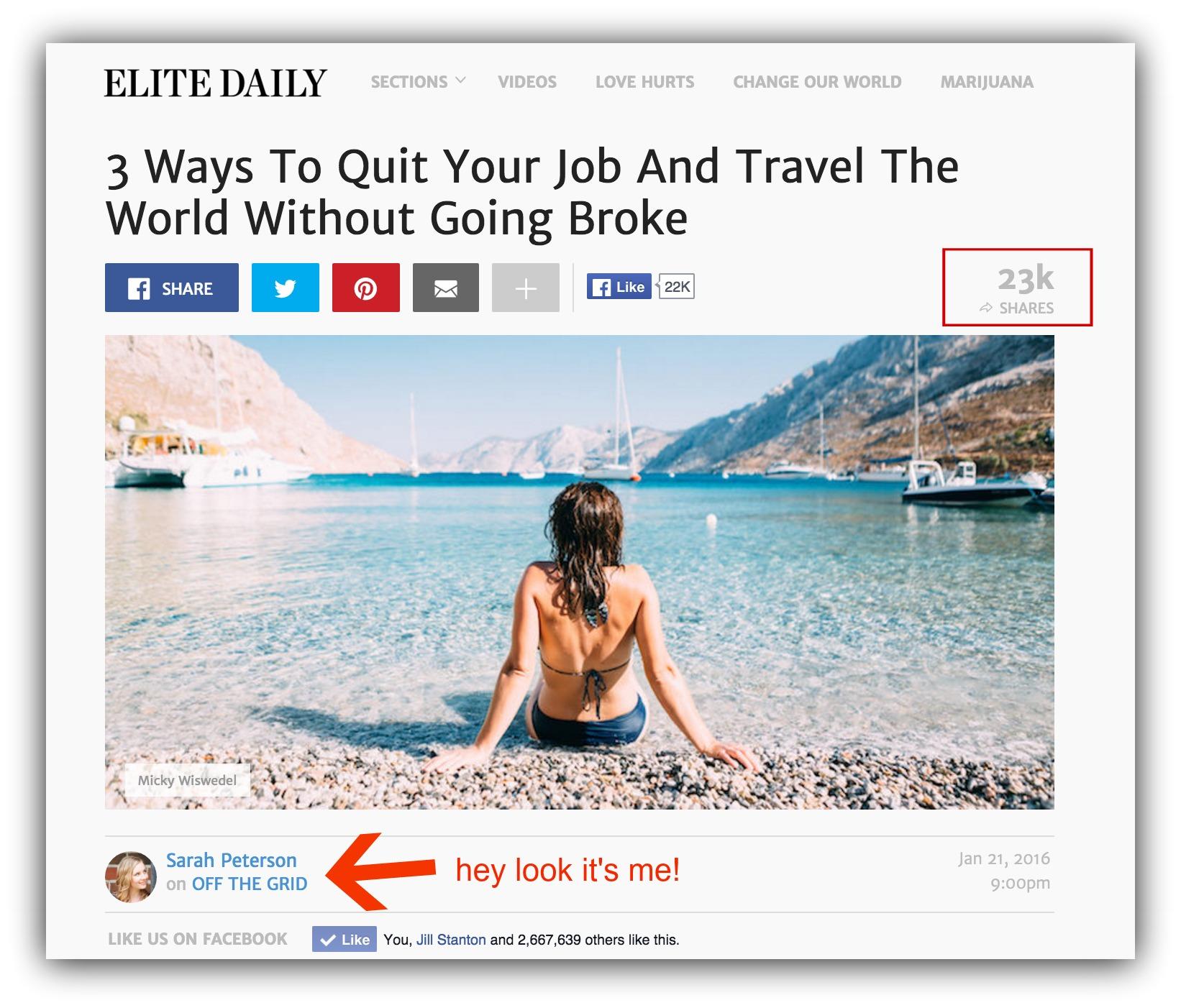
Which then led to over 1300 new email subscribers in just three days:

This is just 24 hours after the article had been published.
I’m not saying this to brag.
I’m telling you this because I’ve cracked the code on massively popular content with no previous notoriety or special ability.
I started my business in January of 2015, and almost immediately it was profitable. Within months I was able to make a full-time living from it, and I attribute almost all of my success to content.
Even Noah found me through a piece of content I’d written.
Every day I wake up to freelancing offers, collaboration inquiries and people asking to be coached by me…
All because of a handful of highly strategic pieces of content I created that keep paying massive dividends.
Whether you run a service business and want to attract more clients, want to get the word out about your product, or just want to get in front of the eyes of influencers and audience members alike, content marketing works.
True to traditional Sumo form, I’m going to walk you step-by-step through exactly how to write massively popular content – from where to publish it, picking the topic, to how to make sure it's the BEST on the topic out there.
This is an extremely detailed guide, and you'll get the best results if you go through it step-by-step. We've created a checklist to keep you on track:
Here's what we'll go over:
- Research to Find Your Topic
- Find Out What’s Already Out There
- Start Creating Your Content
- Hit Your Audience Where it Hurts
- The Final Polish
- Crowdsource Feedback
- Rinse and Repeat
But first, a small caveat…
It’s Pointless to Publish Your Amazing Content On Your Own Website
Shocking, right?

When I discovered this, it surprised me, too.
Did you notice how all of my examples were not from my personal blog, Unsettle? Assuming you’re reading this because you want more traffic, subscribers, and ultimately more money, this is absolutely true for you.
On the other hand, if you’re reading this and have already built an audience of raving fans who spread your awesome content like wildfire, go back to whatever you're already doing and stop gloating.
Writing content for your own website when it’s still small, no matter how epic the content is, is sort of like working for weeks on writing an amazing speech…
Then delivering it to your friends and family in your living room.
Womp womp.
Marketing 101: Figure out where your target audience hangs out. Get in front of them.
It’s far easier to get in front of your target audience where they already hang out than trying to shepherd them over to your domain.
You’ll drive more traffic, email subscribers, engagement, and customers by publishing epic content on publications that already reach your audience.
So before we get into the steps, open a Google Doc and brainstorm 10-20 blogs that already reach your audience.
The blogs you list should hit two criteria:
-
Reach a large, highly targeted group of your ideal audience members. Don’t be afraid to list the most popular publications in your industry.
-
Have a strong community/loyal fan base. Your efforts will fall flat if the community isn’t engaged.
Once you have a solid list, start going through the list and begin to rank them based on the ones you want to target first. Here’s how I go about it:
-
#1 Targets: These are the blogs and publications that have extremely engaged communities with a lot of followers on social media, comments, and other engagement. Typically, these ones will be single-authored blogs with notoriety in your field.
-
#2 Targets: These are blogs with loyal followings that receive a lot of comments and engagement, but are a bit smaller than the first target websites.
-
#3 Targets: These are the websites that take republished content, so are typically larger, multi-authored blogs and publications (like my example with Elite Daily).
The #1 targets are the blogs you want to publish this epic content on. #2 targets can be looked at after you’re published on the the first, and #3s should be set aside for republishing to save you time.
Once you have a ranking system in place, and you’ve identified a few #1 targets, it’s time for the fun part…
Creating the most epic piece of content the interwebz has ever seen on your topic.
Ready?
Let’s do this.
Step 1: Research to Find Your Topic
I know, I know. Research is not the most fun thing to do, but it’s worth it. I Promise.
You have to go to the library and crack open a book. But you do need to find out exactly what is popular in your industry or niche so you don’t waste your time writing an epic article about a topic nobody wants to read about.
Creating an epic resource takes a lot of time (this guide has taken me over 26 hours to write – not including formatting, loading, and editing). You don’t want to waste yours.
A great place to start is by going where your audience already consumes similar content: popular blogs in your industry.
So start with revisiting that list of 5-10 of the top websites and blogs in your space.
If you were in the fitness industry, maybe you would start with Nerd Fitness and The Four Hour Work Week Blog.
If you can’t think of the top blogs in your industry – or maybe you just haven’t come across them – you can find them a couple of different ways:
-
Use Alltop.com: Alltop is an aggregator of publications sorted into topics. You can either search by keyword or by topic to find the most popular publications in that industry:

-
Search keywords on BuzzSumo: Often the reason content becomes popular is because it’s published on a popular website. It makes sense, too; popular publications have large audiences to read, share, and distribute the content, hence amping up their popularity. That’s why republishing works so well.
You can find these popular publications by looking up popular content in your industry. Head to BuzzSumo and type in common keywords of your industry. I typed in “website traffic” as an example, to bring up results of the most shared content on the topic:

The most popular content about website traffic is not surprisingly on some of the most popular publications in our industry (see us up there? We’re officially one of the cool kids).
I’m going to get hot and heavy with BuzzSumo in this guide, so you might as well just bring the tab up and keep it open.
After you find the most popular publications in your industry, you need to find the most popular content on those blogs. So let’s pull up BuzzSumo once again.
I’ll use Sumo as an example. Type in the URL of the blog section of the popular blog or publication:
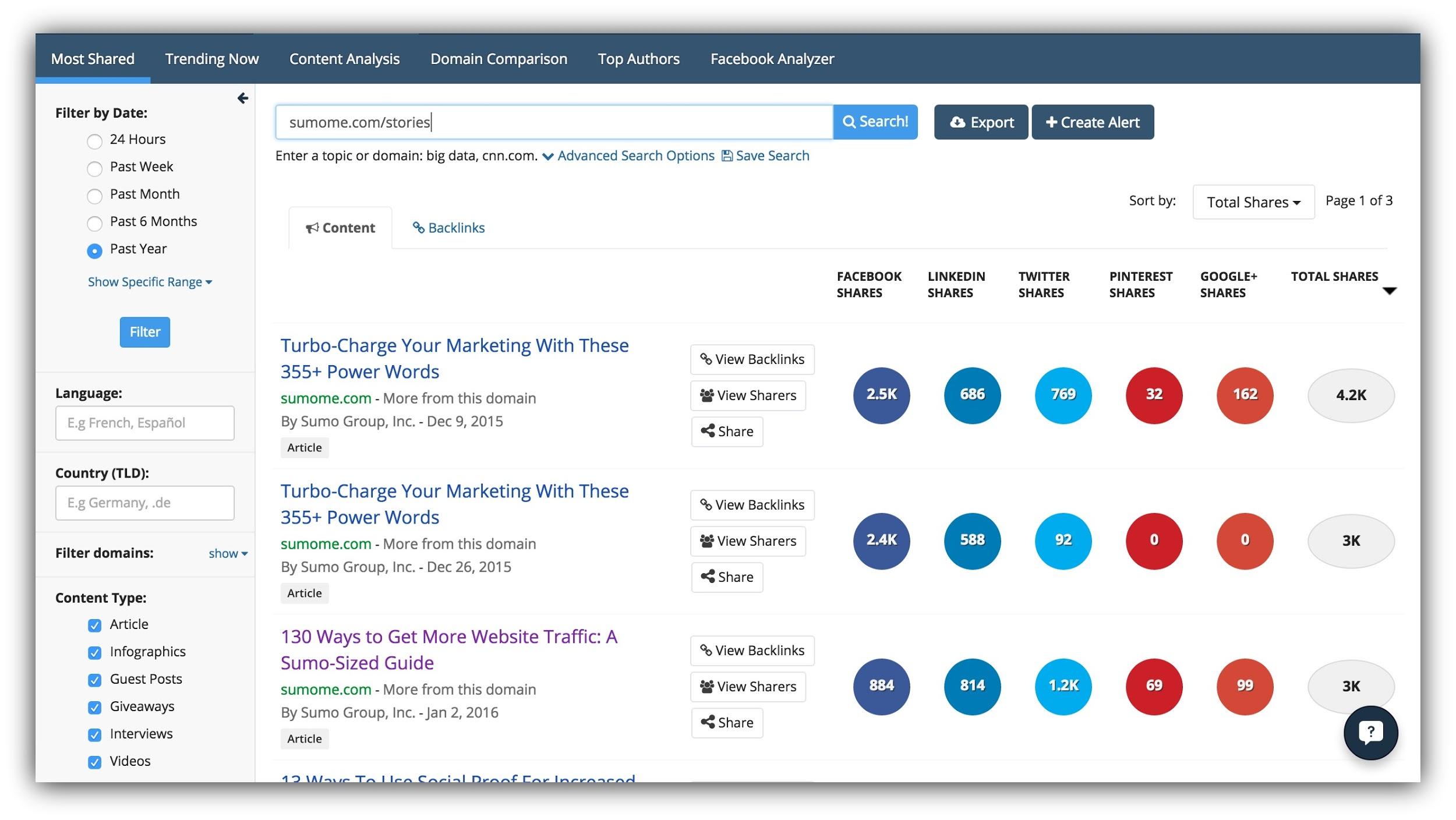
You’ll see the top content published ranked by social shares on the right.
Put your party pants on, because your path to discovering a magical topic starts here.
Note Any Themes or Trends
In another Google Doc (or on another napkin, I’m not judging), start noting any patterns you see between the topics of the most popular posts.
Using Sumo as an example, there are three themes in our top content:
-
Conversions
-
Email lists
-
Website traffic
As you do this with all of the popular blogs you listed, you’ll probably see universal trends in the topics:
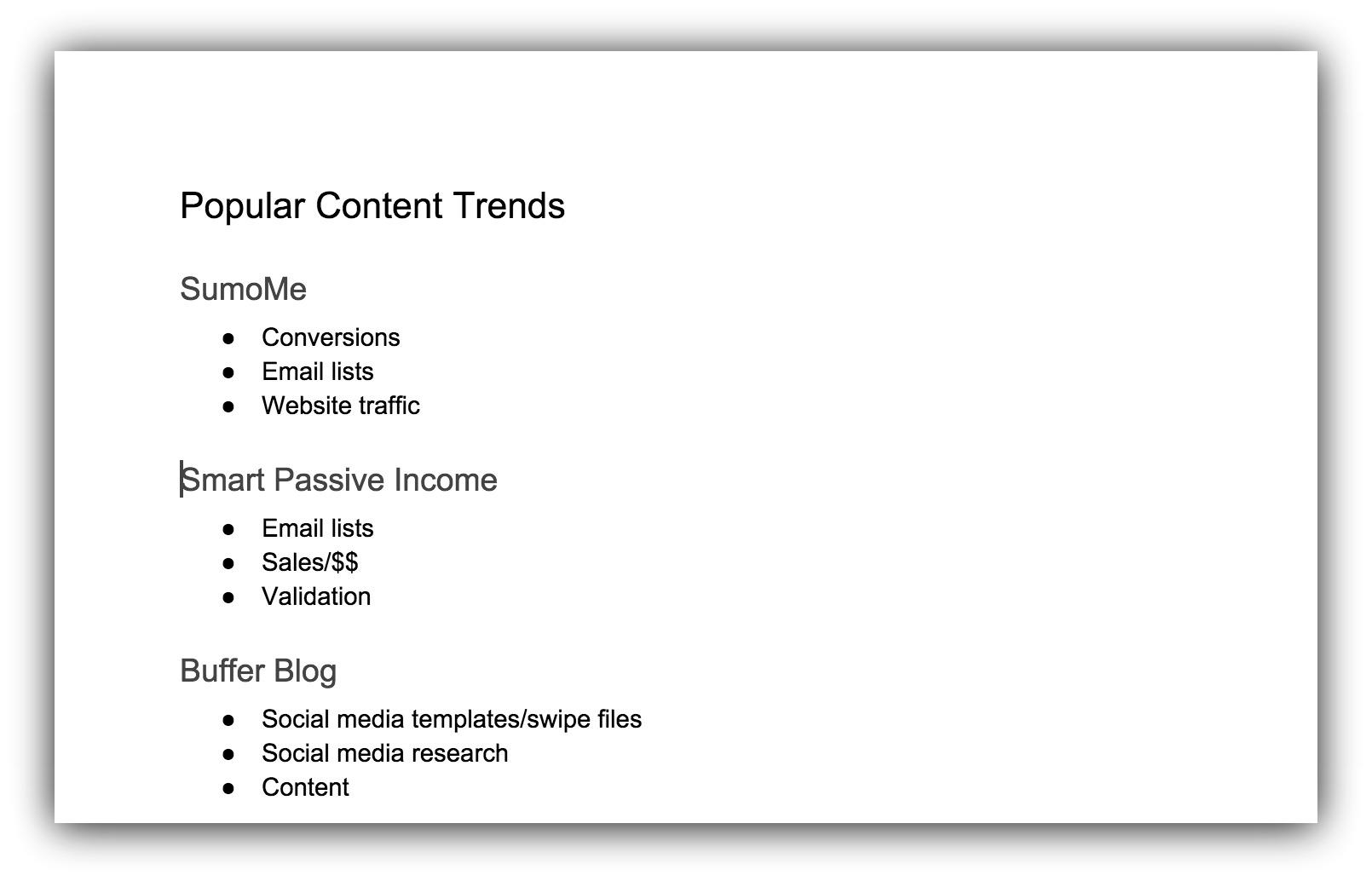
The more often the theme appears, the more enticing the topic is to your target audience. Once you’ve noted themes, you can go onto the next step:
Digging Into Discussions
One of the best ways to find topic ideas for your content is to eavesdrop on the discussions already being had.
We’ll start by opening all of these links, starting with the first one, and working down the list. Focus on content that has >300 social shares. This section can be a bit time intensive (but SO worth it) and you want to spend your time where it’s effective.
Using Sumo as an example, we’ll start with opening the most popular article on the blog:

Then, scroll down to the comments section.
Start reading through the comments so you can find out exactly what the reader wants. Sometimes, they ask questions which is a great indicator that they want to hear more about that topic…
But sometimes they mask their questions in statements or what they’re struggling with.
Small hack: If there are hundreds of comments, you can filter it out by pressing command + f (Mac) or control + f (Windows) and just searching for a question mark. This will highlight all question marks on the page.
Read through the comments, noting any questions and remarks about what the reader wants more information on. For example, here are some comments on our guide 13 Ways to Use Social Proof for Increased Conversions:
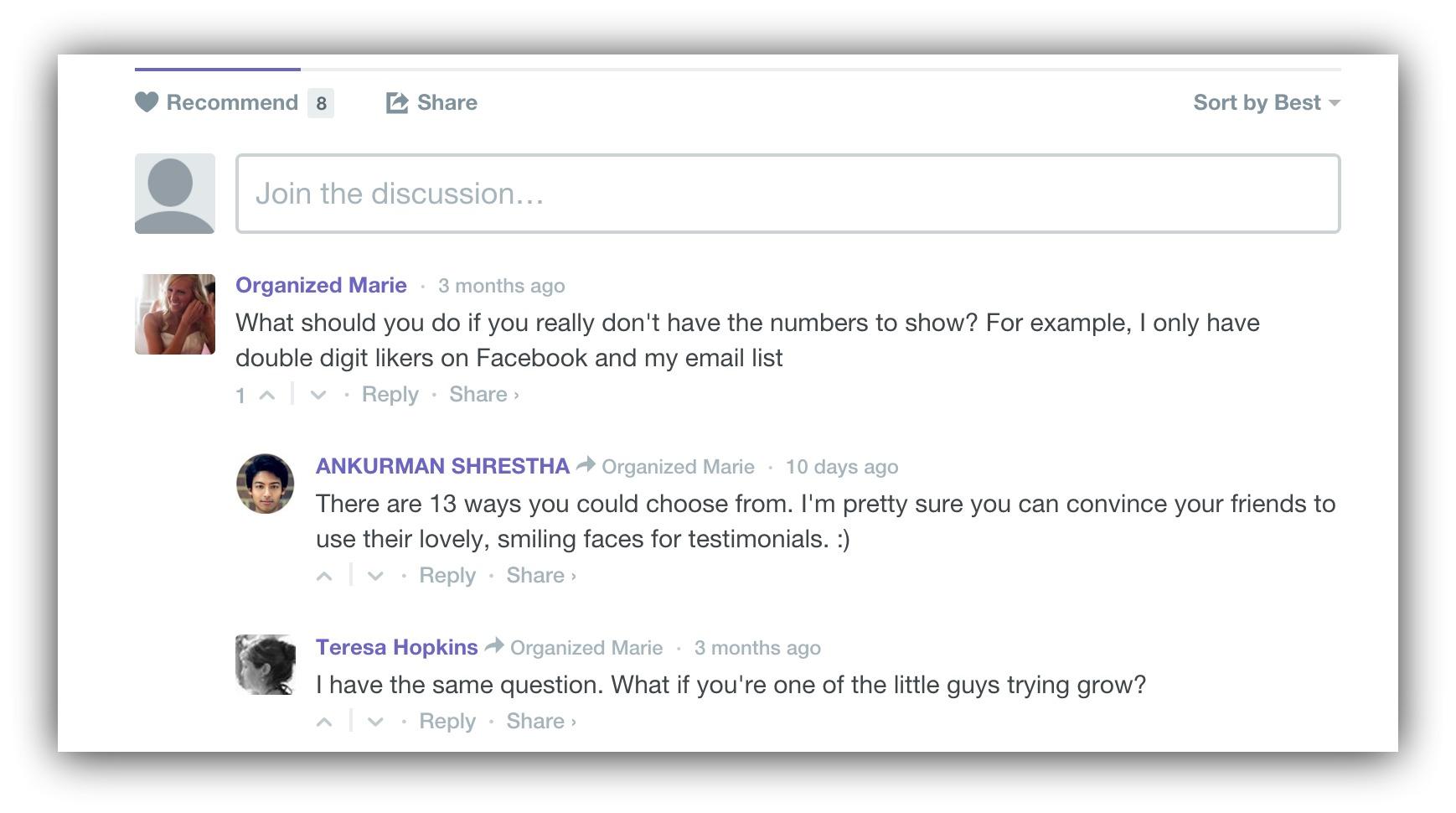
I’ve organized my thoughts in my Google Doc by copying and pasting the comment beside a keyword that identifies the topic of the article:
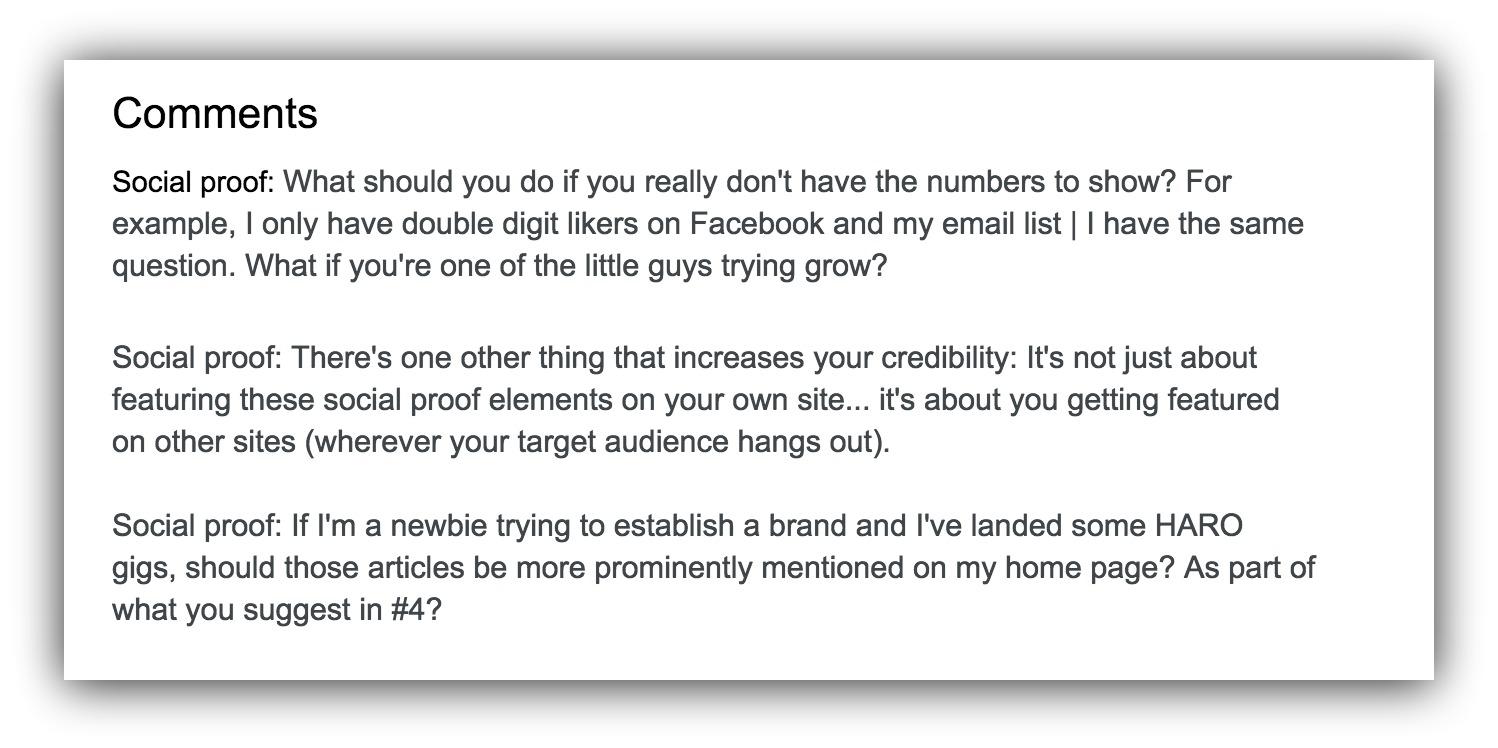
It’s crucial that you copy and paste the comment in raw form. You’ll find out why soon – but actually copy and paste the words the commenter used.
As you do this for even a couple of minutes, your creative juices should already be flowing. The screenshot above is just the initial couple comments on our social proof guide, and already I have a million ideas for new articles…
Side note: In fact, this exercise is how I came up with the topic for another popular guide on the Sumo blog: How To Get Featured on Large Publications (Without Guest Posting).
As some nice social proof that what I’m teaching you works, that guide got a ton of attention, including being shouted out by Darren Rowse of Pro Blogger:
It received 1.4K shares and nearly 100 comments.
As you dig into the comments on each piece of popular content, keep noting the ones that ask questions, open a discussion or even conflict with the content.
My hunch is that you’ll have plenty of topic ideas just after this step and the previous step, but if not, you can check out Amazon book reviews like I showed you in my Zero to 10K guide to find out what types of questions are being asked.
Make sure all of the boxes are checked before moving on to the next step!
Checklist
- Did you search for popular publications in your industry and make a list?
- Did you use BuzzSumo to research the most popular topics in your industry?
- Did you note the trends in your industry in comments sections and on Quora?
- Did you organize your findings in a document, copying and pasting the exact words commenters used?
Choose Your Topic
You probably have a gigantic list of potential topics by now, including comments, ideas from your Amazon and Reddit research, not to mention topic ideas from other publications in your industry.
So let’s start by organizing the data.
Because apparently I love rating scales, I like to put a number beside each topic I’ve listed in my Google doc:
#1: Shows up most frequently, high urgency for target audience
#2: Shows up less frequently, but high urgency for target audience
#3: Shows up frequently, but low urgency for target audience
#4: Shows up less frequently, low urgency for target audience.
Here’s a pretty visual:
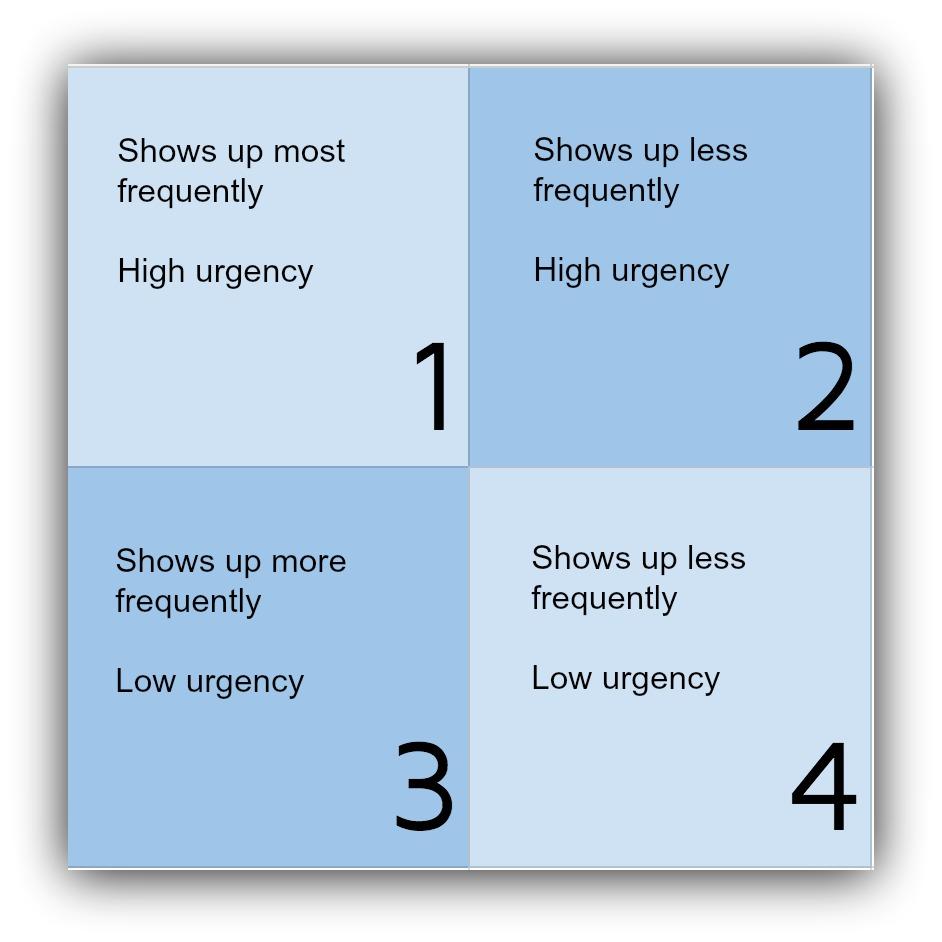
Think of urgency as how worked up your target audience about the topic – or, in Noah’s words, how high it is on your customer’s totem pole.
For example, if you have a gardening business, content in the fall about how to winterize your garden will be higher on the totem pole than how to plant spring bulbs.
Frequency is just about how often you listed the topic. The more the topic is listed, the more you found it in your research, which is a good sign.
Rank your topics with this rating scale, and then narrow it down only to the ones and twos.
If you have more than one of each, choose the topic that excites you the most. Every time I’ve written something that I didn’t have fun writing, it falls flat, and you might as well have fun with this!
Checklist
-
Did you rate your topics based on the rating scale?
-
Did you choose a high urgency, high volume topic?
Step 2: Size Up the Competition
Now that you’ve chosen your topic and have done some preliminary research, it’s time to size up the competition.
After all, how can you possibly write the best of the best content if you don’t know what you’re competing with?
Let’s start with a little intentional procrastinating:
Read What is Already Published on Your Topic
To find out what you’re competing with, pull up BuzzSumo and type in your keywords for your topic.
Let’s say I chose to write a guide on how to get more social proof – even if you’re starting from scratch. I would type “social proof” into the search bar at BuzzSumo:

And then I would go consume all of the content on the topic.
Reading articles, listening to podcast episodes and watching videos may feel like you’re procrastinating, but you’re not. You just need to know what is already out there so you can make the best resource available.
As you’re consuming the content, take notes in your Google Doc:
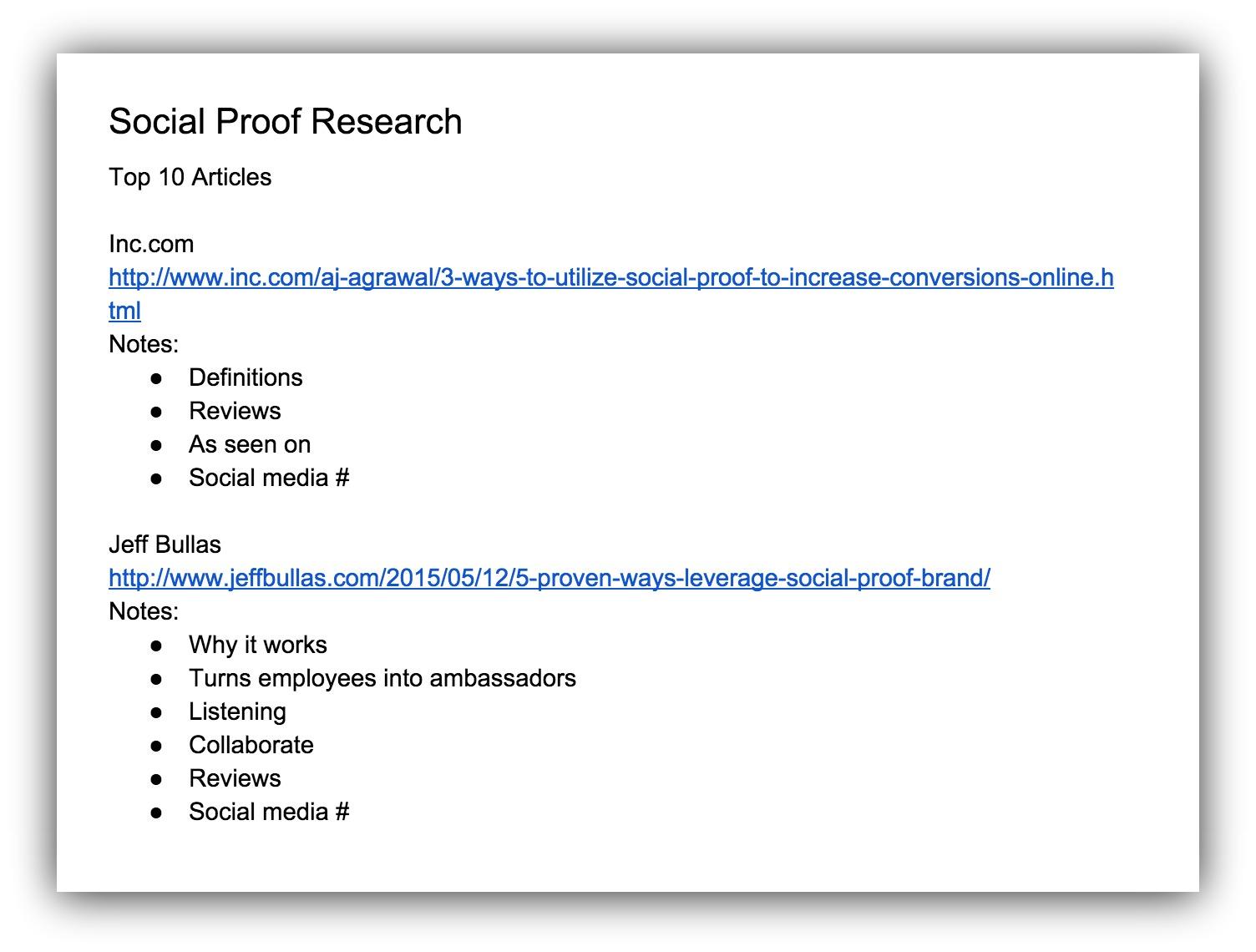
Note anything you agree with, disagree with, find unique, controversial or interesting, and the flow of the existing content.
Remember that you’re not noting these things to copy it – rather the opposite. You’re taking notes so you can address every last aspect of your topic in your content.
Once you’ve done this for the top 5-10 pieces of content on your topic, you can move on to analyzing the top content in your industry.
Analyze The Most Popular Content In Your Industry
There are a few reasons why you must pay attention to the top content in your industry overall (not just the content on the topic you chose):
-
It gives you an idea of what type of content to create
-
It gives you an idea of the qualities of top content.
So pull up BuzzSumo (yes, again) and type in some keywords for your industry:
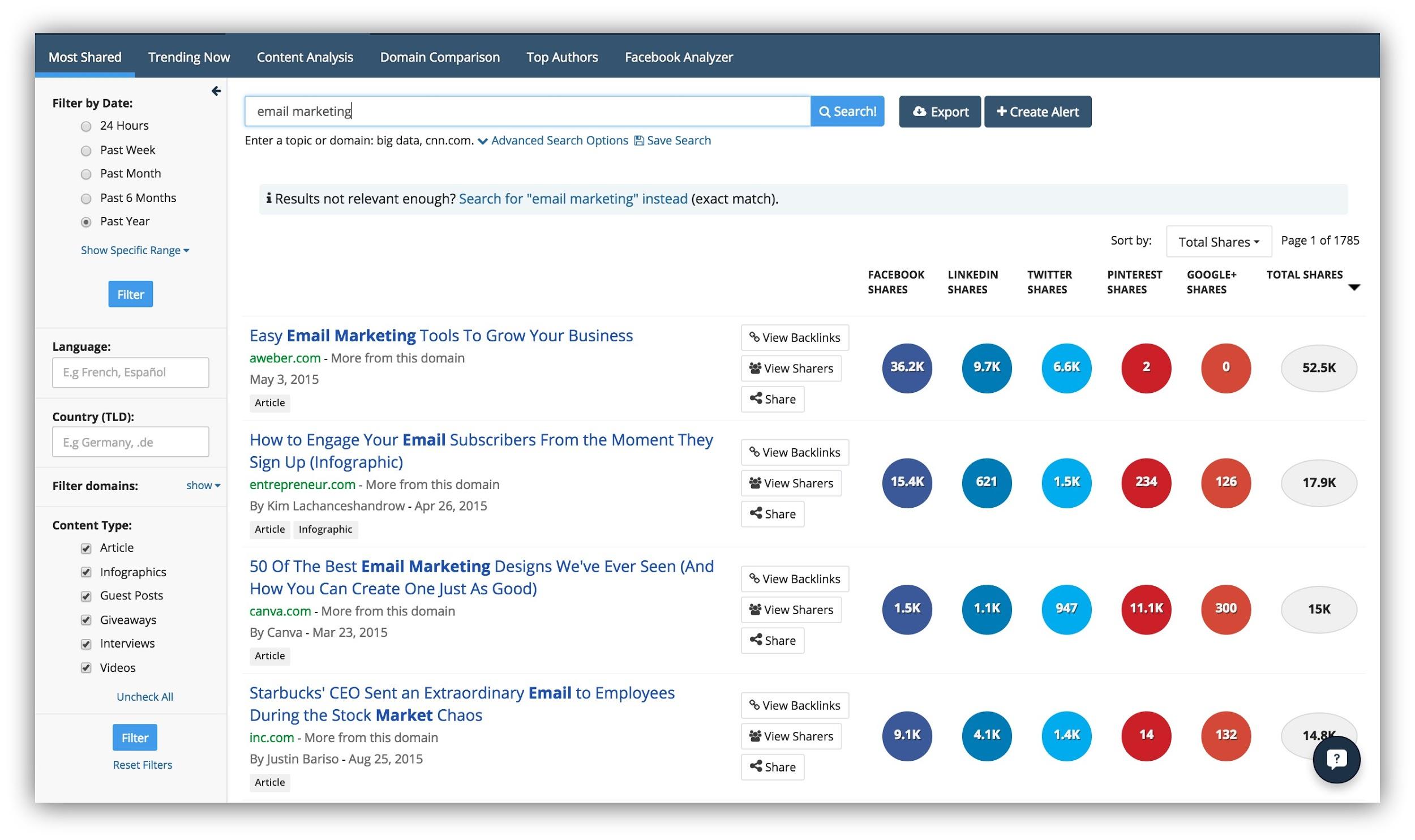
Open the top pieces of content and look for trends. Note:
-
Length of content
-
Format (list post, guide, tutorial, visual)
-
Tone (more casual, or more buttoned up? Funny?)
-
Trends in the angle (examples, tools, etc)
-
Calls to action
Analyze the qualities that make the current best great, so you can then reverse engineer those qualities into your own content.
A good example of this is when Noah did this on Pat Flynn’s podcast . He wanted to make the episode the most popular episode ever published, so he analyzed the current most popular to find out what put it in the top spot:
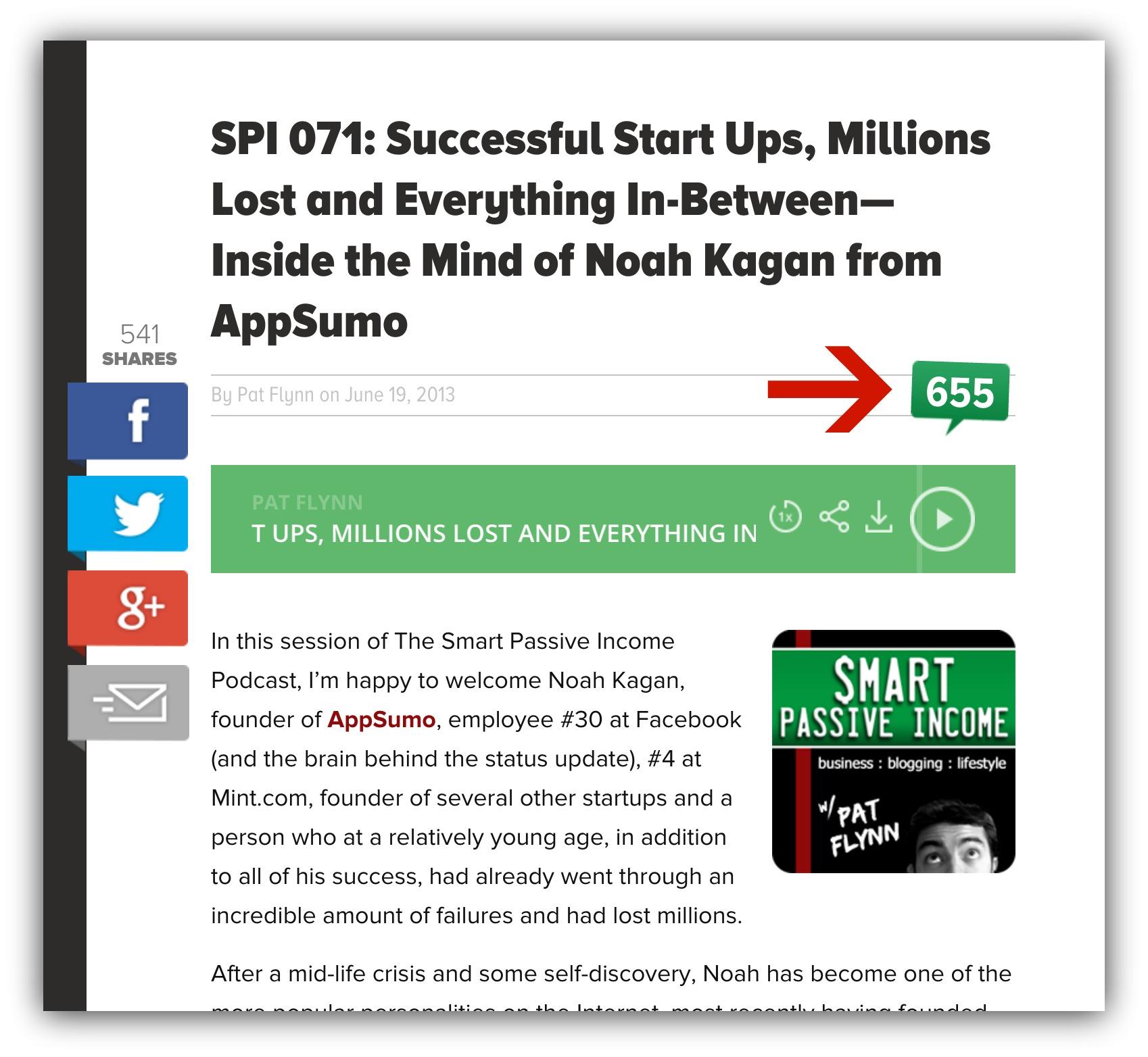
We’ve done this with Sumo articles by looking at what content performs the best and dissected exactly what qualities it has. The most popular content on marketing and business growth has a few things in common:
-
It’s detailed and step-by-step
-
It’s insanely useful and actionable
-
If executed, results are almost inevitable
-
It’s longform and doesn’t leave anything out.
And guess what we deliver on Sumo?
Step-by-step, actionable longform guides that, if executed, will almost guarantee results.
Like this one:
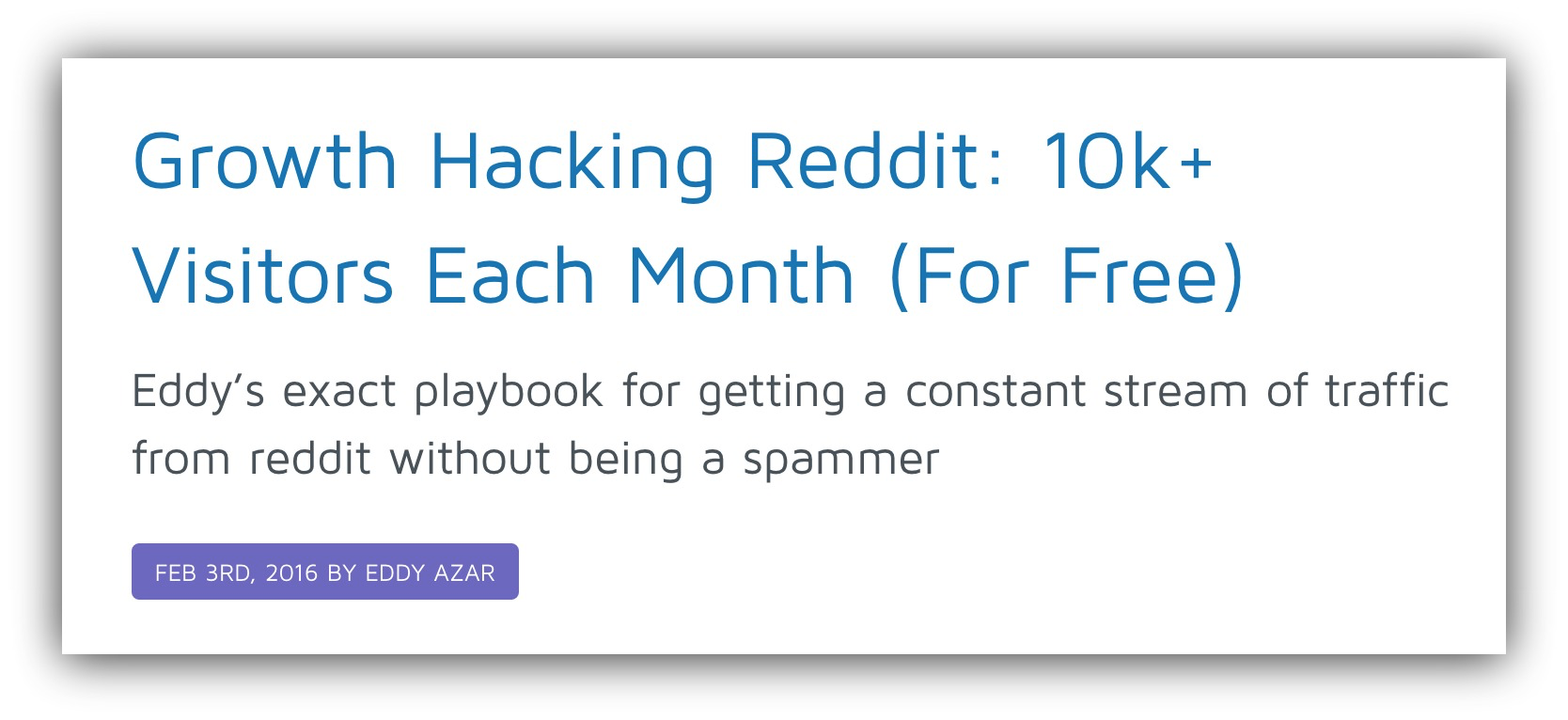
And this one:
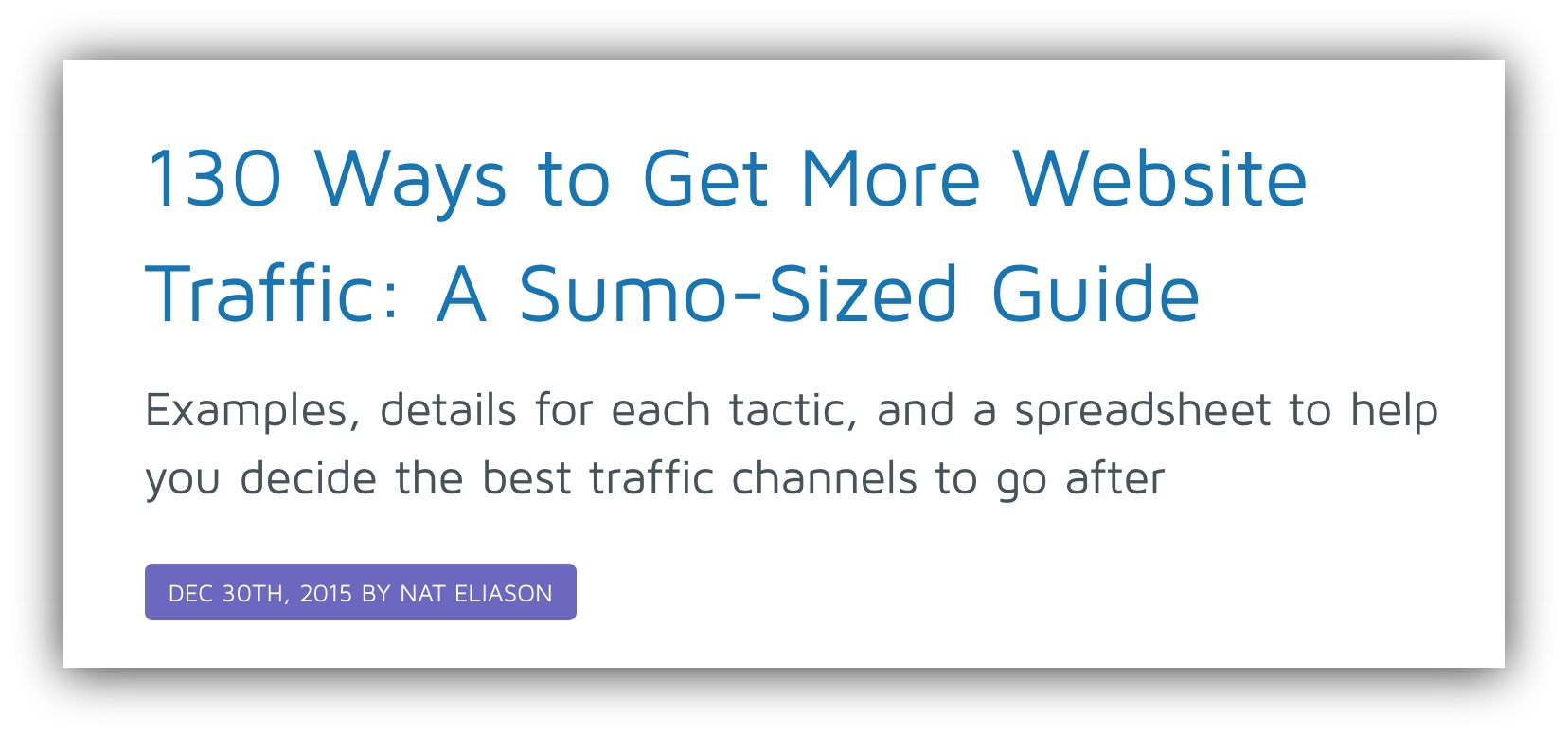
And this one:

Once you do this once you pretty much always have the answer to what is popular in your industry, and you can apply it to all of your content.
Checklist
-
Did you read the top 10 pieces of content on your chosen topic?
-
Did you find trends in your industry with length of content, format, tone, angle, and calls to action?
Step 3: Start Creating Your Content
After you’ve chosen your topic, it’s game time.
Hope you’re excited, because actually creating the content is the fun part. But first, you must…
Choose What Type of Content to Create
Every industry has specific types of content that work.
In marketing and business, detailed longform guides work like magic. In the fitness industry, instructional how-to information works well. In inspiration and habits, shorter list posts work.
You should have been able to glean what type of content works for your industry in the last step.
Different audiences also respond to different things. For example, articles on Entrepreneur.com should be short lists or easy-to-follow editorial pieces:

The larger the publication (think Huffington Post, Entrepreneur.com, Elite Daily), the shorter and more broad the content can be, so you can usually assume that you’ll have to create more in-depth, longform content.
If you want to get the most bang for your buck (and time) with the content you’re working so hard to create right now, choose only one of the following types of articles:
-
List posts: Content that follows a list format, like our 130 Ways to Get More Website Traffic.
-
Ultimate guides: A definitive resource on your topic usually guiding the reader through a process, like our How to Get 1,800 Email Signups from One Guest Post
-
Expert roundup posts: A post where you bring in expert opinions on a central theme or topic.
-
Example roundup posts: Content that features experts by using them as an example.
Once you've decided what type of content to create, you can…
Brainstorm Your Points
Have you ever seen an author plan a book?
It’s a fascinating process.
It usually starts with a stack of sticky notes and a blank wall, or maybe a huge whiteboard. I hear kids these days are using something called Scrivener…
Anyway. For an author, the purpose of the sticky notes is to do a total brain dump. Channel your inner author, and after you’ve read the popular content published on your topic, get all of that information out of your head.
Do this directly after you’ve consumed the content so the topic is fresh in your mind.
Start brainstorming absolutely absolutely everything about your topic – points, arguments, words, even just small asides. Even if you think it’s trivial, get it out of your head.
I use sticky notes and a wall for my brainstorming, but because I’m rather fond of you, dear reader, I’ve typed up my process as an example for a future social proof guide:
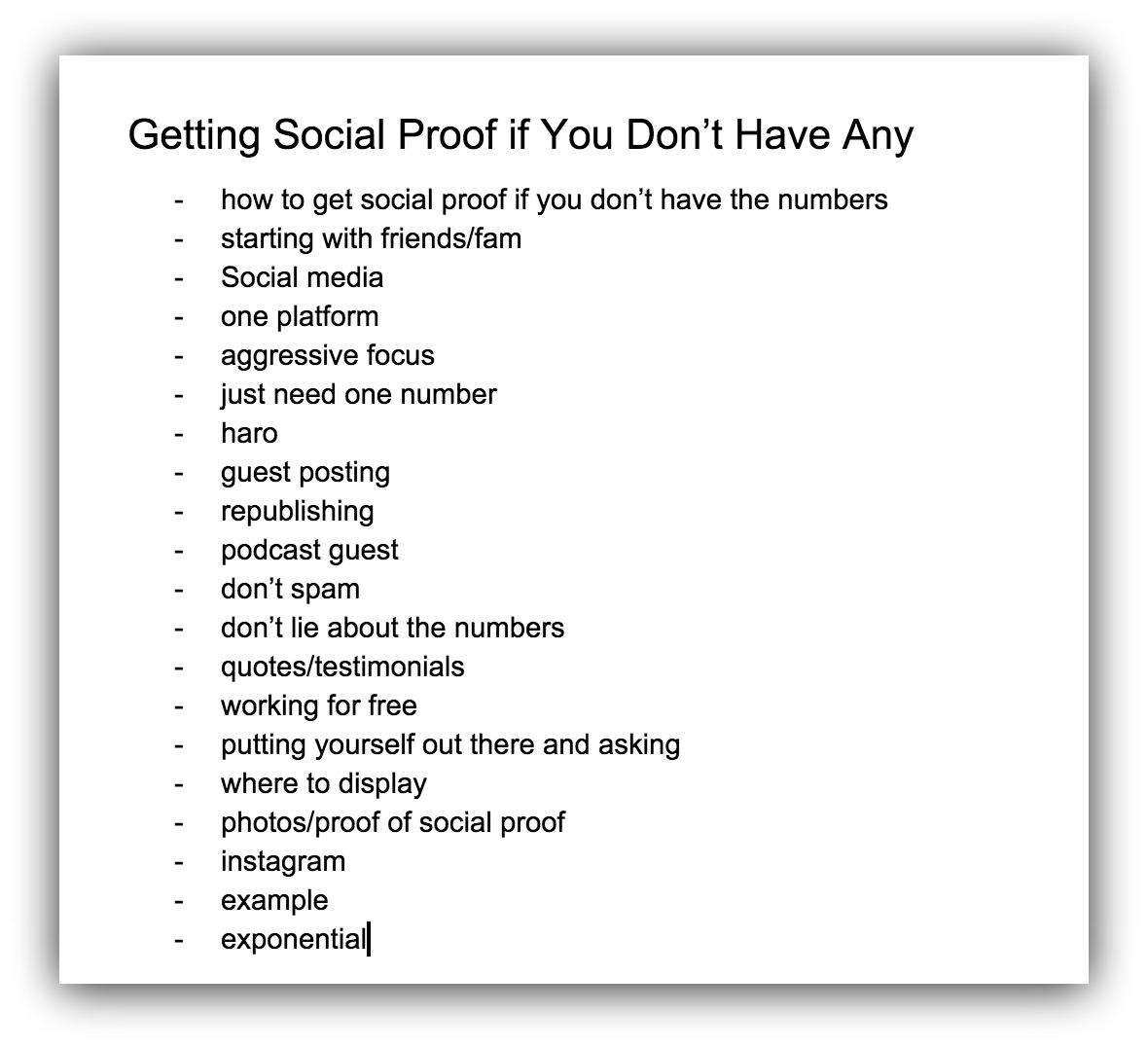
Yours will be far longer than my example.
After you’ve done a brain dump of everything already in your head, it’s time to fill in the gaps.
Leave No Stone Unturned
You don’t want to just create content that is the best right now.
You want to create content that is the best right now, and remains the best in the future. So you can’t leave a single stone unturned.
Because we’re humans and not robots (unless you actually are a robot….) it’s impossible to think of absolutely everything. So that’s why we need to turn to the audience once again.
My favorite way to do this is to head to Quora, and begin reading through questions and discussions about the topic. Using the social proof example, I typed in the keywords to bring up the questions on Quora:
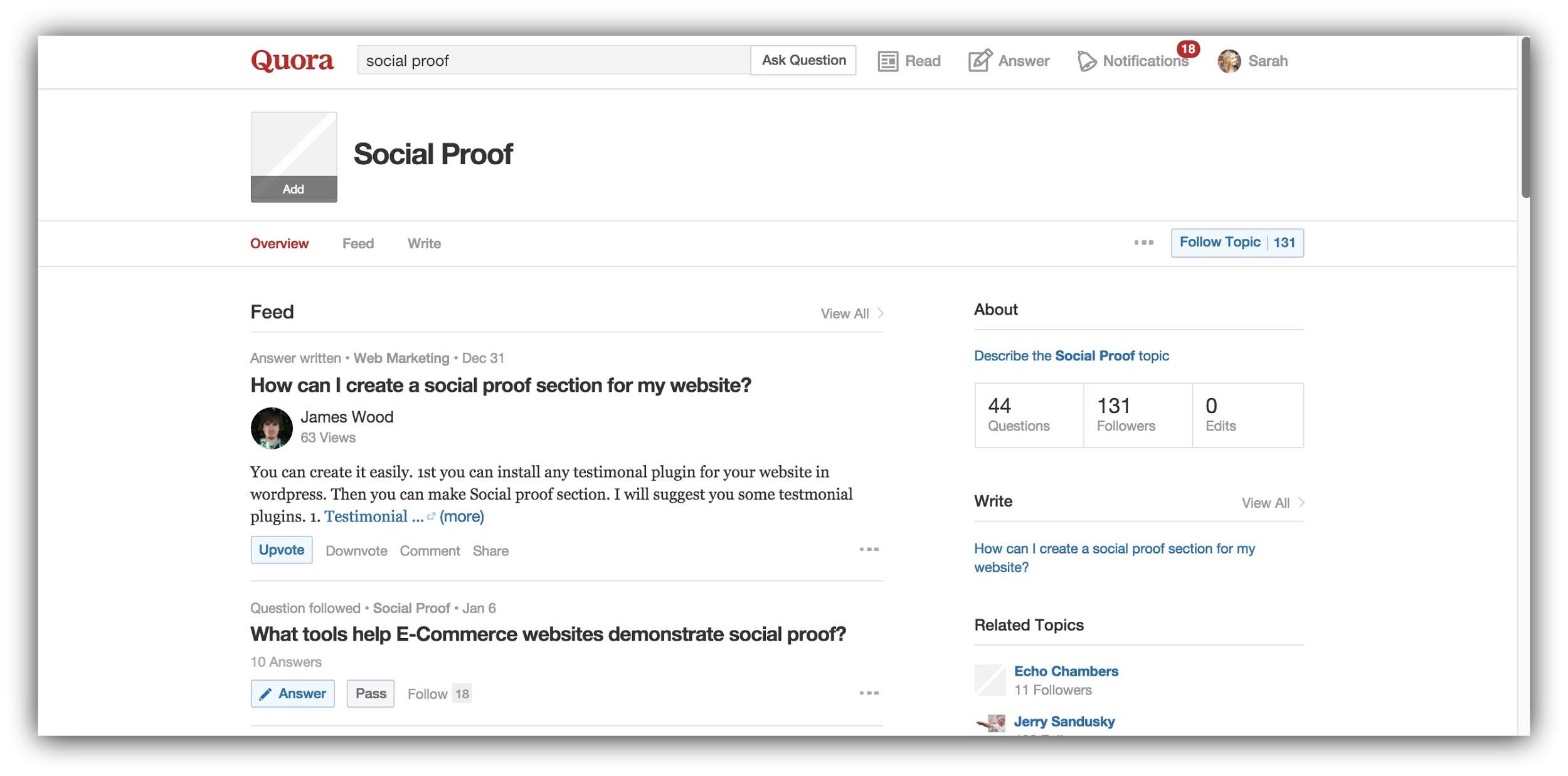
Then, click into any relevant questions you see:

Include anything from the questions and the answers you’ve forgotten in your brainstorming session.
Protip: The “Related Questions” section on Quora will save you time from searching (and also give you ideas of what to include in your content).

Add everything you found to your Google Doc:
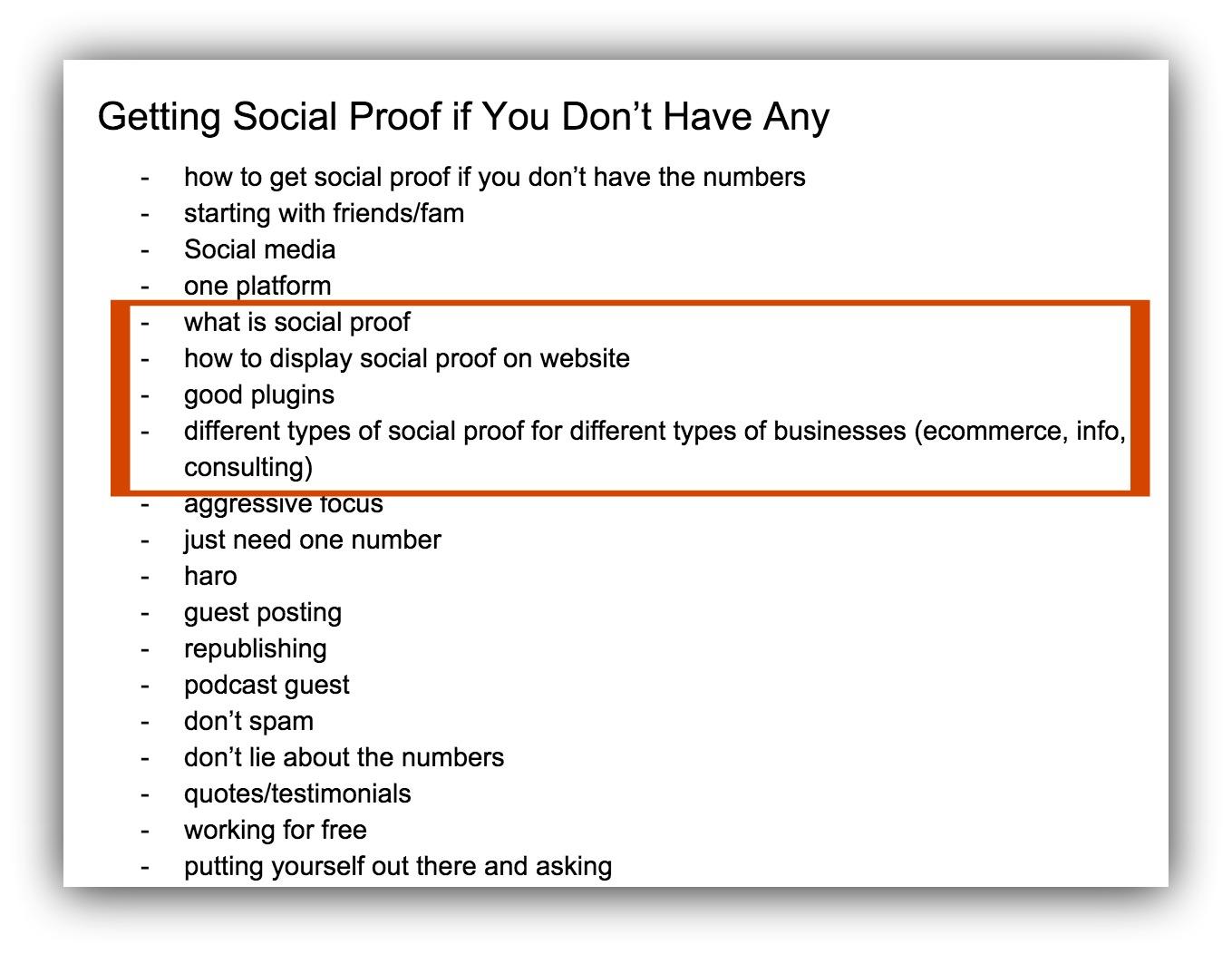
And after you do this, you should have a comprehensive list of points to cover in your content. You can then…
Eliminate the Expected
The biggest distinguishing factor between great content and the rest of the crap online is that it’s not a regurgitation of the same old stuff you’ve read a thousand times before.
Why do you think Ramit Sethi’s blog is arguably one of the most popular personal finance blogs online?
Because where the rest of the world is telling you to cut out your lattes, he’s inviting you – nay, encouraging you – to keep them:

He’s breaking the same old pattern that makes us click off the page – that makes us wary of reading another article to begin with.
Note: Sometimes, the “expected” points are so good that they need to remain. If the content is stronger with the expected points, leave them in, but consider whether there’s another angle or way you can phrase or demonstrate them.
After you’ve eliminated all of the noise, you can start to flesh out the points and actually create the content…
But first you have to get into the right headspace.
Channel Your Inner Reader
There’s something you need to do if you truly want to connect with your reader…
Get into their emotional zone. When you’re in the reader’s emotional zone, you can create content to meet them where they are. You are more empathetic, and that shows through in your content. Ask yourself a few questions:
-
When your target audience is searching for your topic, how are they feeling?
-
What are their goals, fears, hopes, and desires?
-
What have they already tried with your topic?
-
What do you want them to feel after reading your content?
For example, here’s what I wrote down for this here guide:
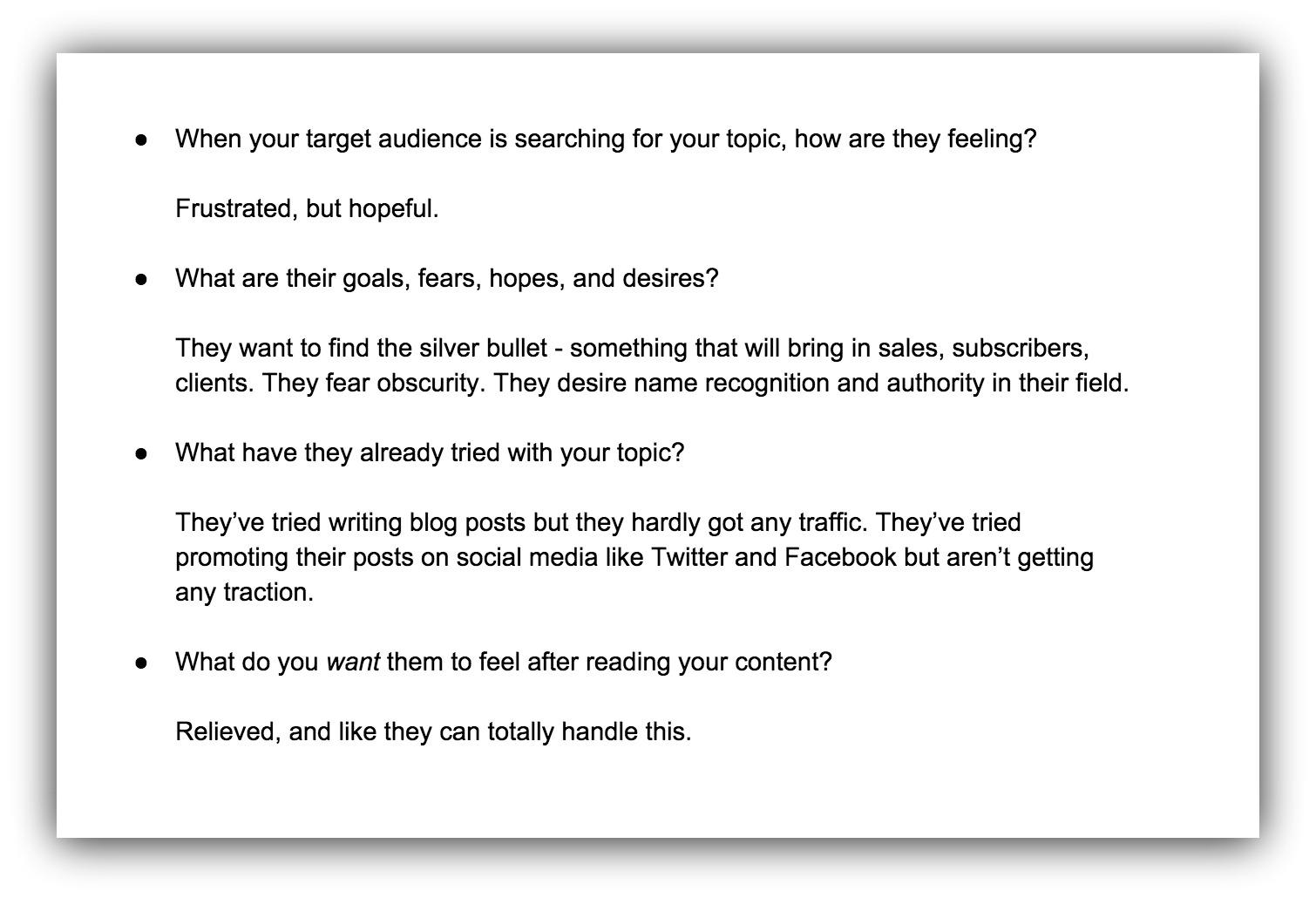
Because I know that many people reading this are frustrated with how their content is currently performing, I’ve made some attempts at comedic relief (even if they failed, at which point you can just laugh at me rather than with me).
I also empathized with you at the beginning of the article, to reassure you that you aren’t alone.
Because I want you to feel relieved and like you got this after you finish reading this, I’ve left nothing out. I’ve included checklists and as much detail as possible.
When you can get into the headspace of the audience, you can connect with them through your content on an emotional level. And in case you need a reminder (because apparently I love to remind you in every guide I write on Sumo), high arousal emotion works for making content popular.
When you’re in the “zone” it’s time to start adding some meat to those points.
Give it All Away
One thing you may have noticed on the Sumo guides is that we give it all away.
We don’t withhold any information just in case one day we want to sell it. We not only develop gigantic, comprehensive guides – really the only resources you’ll ever need on the topic – but we also create content upgrades that we don’t even require an email address for.
For example, this is likely the only guide you’ll ever need about headlines:

And we also gave away all the goodies with our free headline generator, too:

The purpose of this is to make your content so good the reader would actually pay you for it.
When you start receiving emails and comments from people saying things like:

You know you’re on the right track.
Once you’ve fleshed out your points and have created your content, you can go back and include a few things that will take your content from amazing to epic. But first, make sure you’ve checked all of the boxes below:
Checklist
-
Did you choose which type of content you'll create?
-
Did you brainstorm your points by doing a brain dump?
-
Did you fill in the gaps with Quora?
-
Did you eliminate all the expected points?
-
Did you get into your reader's emotional headspace?
-
Did you give it all away?
Step 4: Read Your Audience’s Minds
You want to make sure that your content is not only the best on your topic, but that it’s also the most popular, right?
You’re not putting all this time to be second rate.
For content to be truly popular, it has to resonate with the audience. If you don’t resonate, you can’t dominate.
I like to make my readers feel as if I’m in their heads; like I’m picking thoughts right out of their brains and reading it back to them.
This isn’t as difficult as it seems. Remember when you were digging around in the comments sections of popular articles and I told you to copy and paste the exact words the person used in their comment?
Buckle up because you’re about to find out why…
The suspense is killing you, isn’t it?

You’re going to repeat those words right back to the reader.
You’ve probably heard this notorious quote by Jay Abraham: “If you can define the problem better than your target customer, they will automatically assume you have the solution.”
And the language your target audience uses to phrase problems, questions and assumptions about your topic defines the problems they’re experiencing with it. We love to hear our own words repeated back to us.
Research proves it.
Rick Van Baaren conducted a study where he had servers in a restaurant take orders.
One group of servers would acknowledge their customer’s order with a head nod or some sort of verbal approval. The other group of servers were told to repeat the exact words the customer used to place their order back to them.
So if the customer was ordering a steak and asked for it to be “a little red” rather than “medium rare”, the server would say “a little red”, too.
Unsurprisingly, the second group of servers, who repeated the exact words the customer used enjoyed a 20%+ increase in tipping customers (from 52% to 78%).
I know you’re not working for tips, but this works in content, too.
When you repeat the exact language your target audience uses to describe their problems, you resonate with them. They feel as if you’ve read their mind.
Because… well, you sort of have. Remember when I said you’re not a wizard?
I take it back.

So start pulling out those nuggets of genius the commenters left and weaving them into your introduction and the body of your content.
For example, when I showed you a screenshot of the comments I’d been able to mine just from our social proof guide, one commenter described themselves as “one of the little guys trying to grow”:
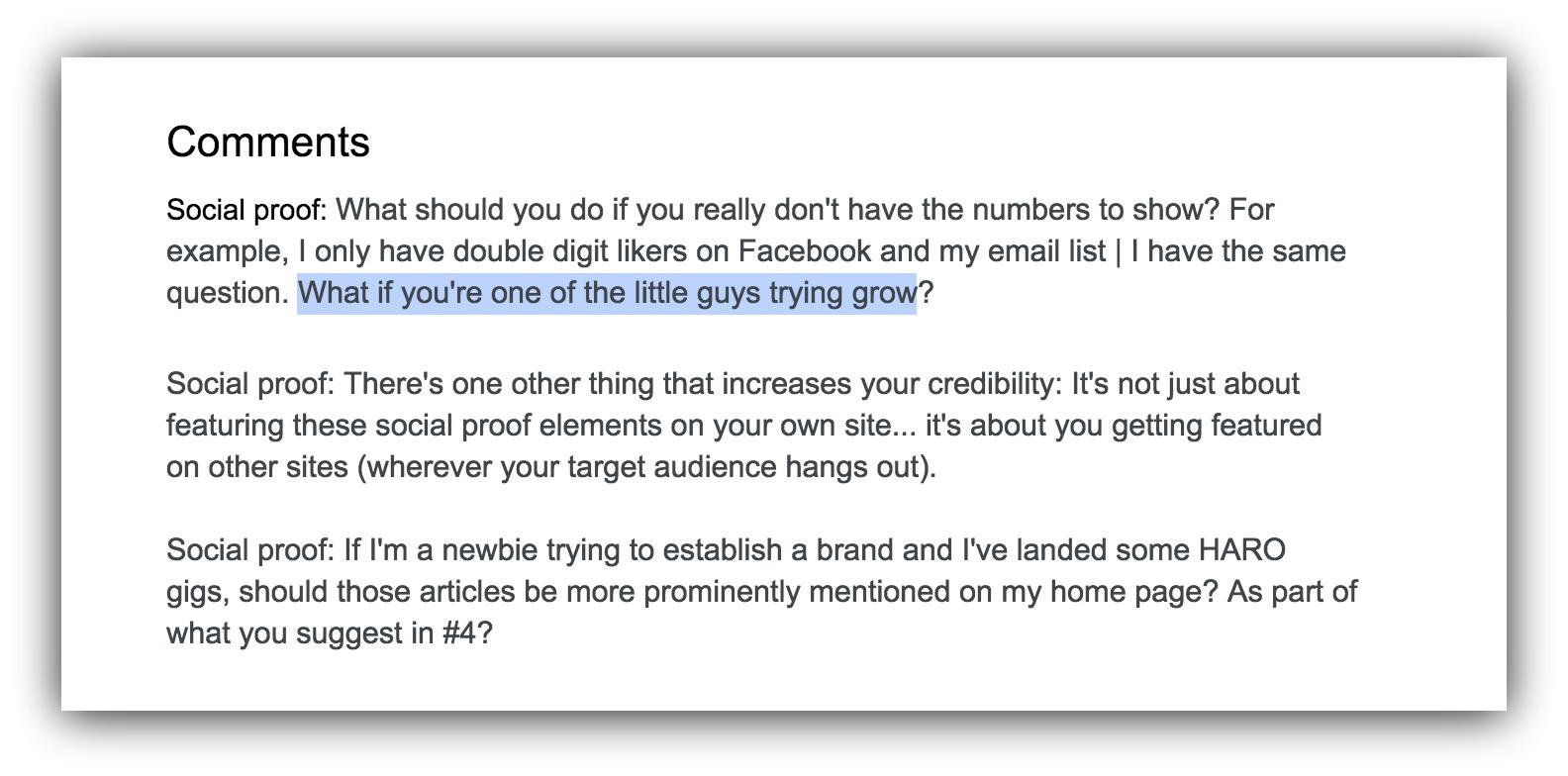
Next time I write an article about social proof and growing your numbers, I absolutely will use this phrase – because it will connect with the reader.
As humans, we think we’re all different, but let’s be honest: we’re not. Most of us think, fear, and strive for the same things. How one member of your target audience describes themselves and their problems will resonate with many more.
Once you’ve woven bits of your mind-reading wizardry into the content, you can move onto the next step…
Checklist
-
Did you review the comments from your target audience you copied into your Google Doc?
-
Did you use the target audience's exact words in your content?
Step 5: The Final Polish
I want to start this section out by saying that you don’t have to be a good writer to create an amazing piece of written content.
I know. Crazy right?
Sure, writing well helps. Knowing the basics of grammar and sentence structure is a useful skill. But what sets an amazing piece of content apart from a mediocre one isn’t grammar or punctuation. It’s the information.
Because I’m also a mind-reading wizard, I knew you were a bit concerned about that. So fret not.
Now that we have that out of the way, let’s talk about the final polish of your content. Give your content a couple of read-overs, flagging a few things for notes and revisions:
-
Are your claims supported by research, expert opinions, and examples: You’re still establishing your expertise on the topic so try to use as many authoritative sources as possible.
-
Did you miss any important points?: Pre-empt any objections your reader may have makes almost all content stronger. Go through and poke holes in your own arguments and points. How can you address those objections?
-
Does the flow and structure of the content make sense? If you try to fit an ultimate guide into a listicle, chances are it will come off as disjointed and confusing. Make sure that the structure of the content flows well from the topic.
-
Did you make your points in the simplest way possible? You can quickly lose your audience by overloading them with too much information. Simple is always better. You don’t have to sound like a textbook!
-
Is your content the only resource your audience will ever need to read on your topic? We ask ourselves this question with everything we publish on Sumo. If the answer is “no”, we fix that.
After you’ve done a few run throughs, you can send it to the troops.
Checklist
-
Did you make sure your claims were backed by research, expert opinions, and examples ?
-
Did you make sure no important points are missing?
-
Did you double check the flow and structure of the content?
-
Did you make your points in the simplest way possible?
-
Did you make sure your content is the only resource your audience will need on your topic?
Step 6: Crowdsource Feedback
Did you know it’s almost impossible to edit your own work to perfection?
It’s true.
There are many reasons why, but when it comes to our own work it’s hard to see the forest for the trees. That’s why the best content creators online have a small group of people they can send their content to so they can crowdsource an opinion.
It takes a village to raise a child… and apparently it takes a village to create the best content on the internet.
Crowdsourcing Content Feedback
Crowdsourcing feedback about your content can make all the difference.
If you have a team, send them your content for feedback and criticism. If you don’t have a team, It’s helpful to build a group of content creators committed to giving one another valuable constructive feedback on content.
I’ve seen people do this through Facebook communities, Slack channels and just through using their networks.
The purpose of this is not just editing (thought editing for grammar is helpful). Get your group to:
-
Poke holes in your arguments and identify weaknesses
-
Let you know if anything is unclear or confusing
-
Comment on the structure and flow of the content.
Every guide I create on the Sumo blog goes through at least a couple of rounds of revisions. Nat and Noah’s feedback makes me level up and turns a strong guide into beastly resources like this one:
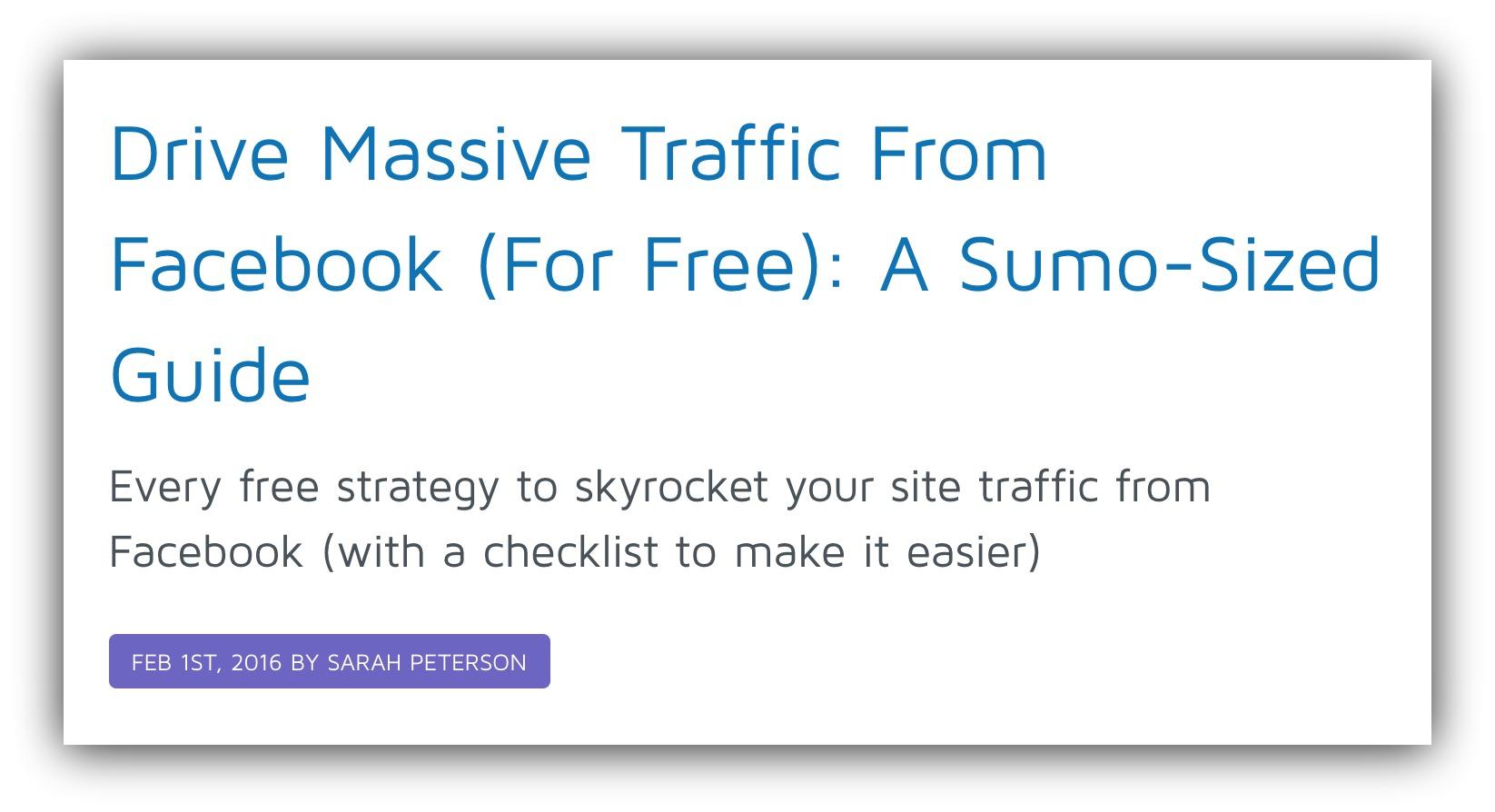
Fun fact: that Sumo-Sized Guide was originally about ¼ of the size and detail.
Sometimes we’re too close to something to see it clearly, so a few questions and pieces of feedback from Nat made me take it in an entirely different direction.
Don’t stop there with crowdsourcing, though. We haven’t even gotten into my favorite part…
Crowdsourcing Your Headline
Remember how I told you about how important your headlines are?
Headlines are part of your content – and they are arguably the most important part. Because if your headline isn’t compelling and click-worthy, your content will go to waste. Nobody will read it, engage with it, or share it.
And that would be sad.

You’ve worked your butt off to create this amazing piece of content. Pairing it with a crappy headline is like wrapping a beautiful diamond ring in an dirty paper bag.
Spend the time to write an amazing headline – and then crowdsource the perfect one.
To do this, start by writing 25 headlines for your content.
Yes, I said 25.
No, I’m not joking. I would have said 50 but I know you wouldn’t do it. Admit it, I’m right.
Upworthy writes at least 25 headlines for every single post they publish. This is based on the idea of writing “shitty first drafts” – if you write 25 headlines, chances are at least a few of them will be gold.
Headline writing is a skill, so while you could just use our headline generator, you may want to practice your hand at writing the headlines yourself – at least at first.
After you write 25 headlines for your content, highlight the top 10. Try to think like part of your target audience. Which of the headlines would you be most interested in?
Then, narrow it down to the top 10, and begin to pit them against each other to narrow it down to the top 5. Take the first one on your list and ask yourself whether it’s stronger than the second one.
Remove the weaker of the two, and then do the same thing with the winner and the next one on your list.
After you’ve narrowed it down to the top 5 headlines, look at how you can improve them. Can you make them stronger with power words or remove unnecessary words?
After you’ve gone through that process, that’s where to crowdsourcing comes in.
Crowdsource the winning headline for your majestic content creation. Volume matters with headline crowdsourcing, so instead of just keeping it to your smaller group of reviewers, take it to Facebook groups you’re part of (I find online entrepreneur Facebook groups to be invaluable), Slack channels, or forums.
It’s best if you can get at least 10 opinions on your headlines.
Facebook groups work great because you’re able to set up a poll and collect responses, like I did with a recent Sumo article:
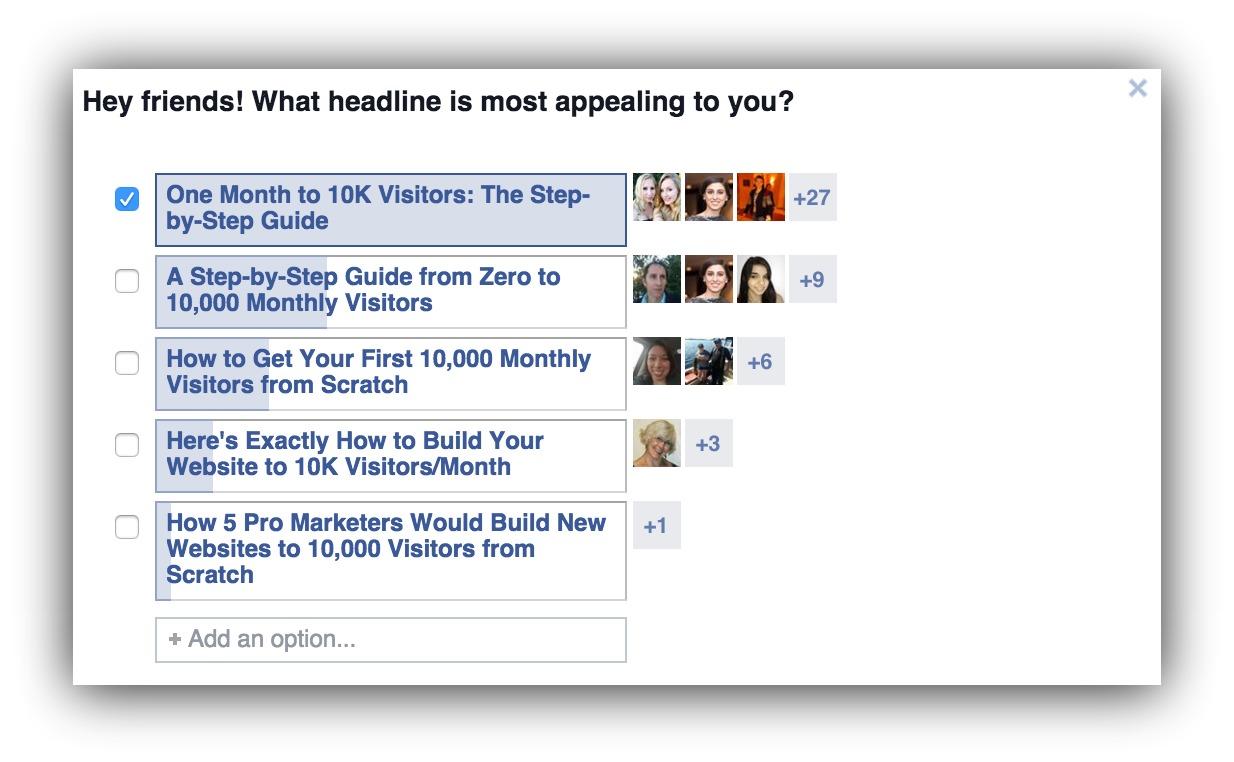
Oddly, the winning headline is never what I think it will be, and you may be surprised with your results too.
And guess what?
Once you’ve officially named your masterpiece, you can ship it.
If you chose to submit it to a publication much larger than yours (which you should), then you can send it to the editor, and sit back and watch the subscribers, clients and traffic roll in.
Checklist
-
Did you find a group of people to review your content?
-
Did you brainstorm 25 headlines (minimum)?
-
Did you narrow it down to the top 5 headlines?
-
Did you crowdsource a solid headline for your content?
Step 7: Rinse and Repeat
You’ve probably heard the phrase “content is king” before, right?
It’s thrown around a lot online for a reason: it’s true.
So you have a choice. You can either create content that will remain firmly planted in obscurity, littering the internet with even more mediocrity…
Or you can create content that will be massively popular from the get go, bringing you clients, subscribers, and leads.
This process can be used again and again. And the best part? With every piece of amazing content you publish, you establish yourself in your field.
Don’t just take my word for it. Try it out.
-
Start with doing the research to find a topic that your audience is hungry for.
-
Next, find out what is already out there on your topic and begin to create your content.
-
Then, polish your content up by ensuring it resonates and crowdsourcing feedback.
And if you’re thinking that there are a lot of moving parts to this, you’re right. That’s why I created this helpful checklist to help you go through the process. Click the link below to get the checklist and stay on track.
And let me know in the comments section below whether you’ll be using this guide to create an epic resource.
-
Add A Comment
VIEW THE COMMENTS